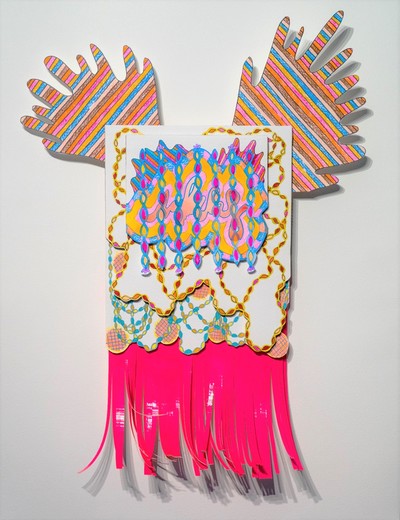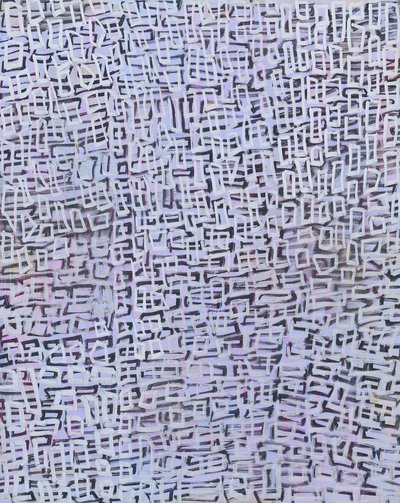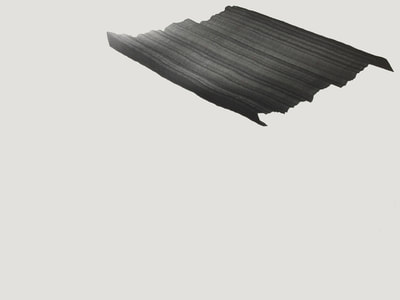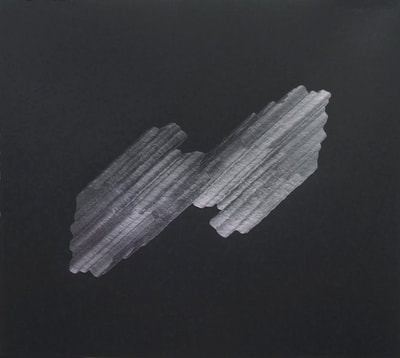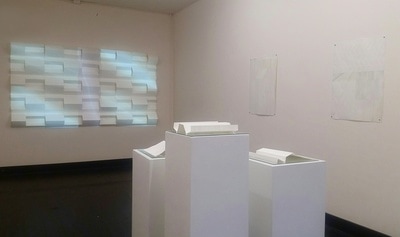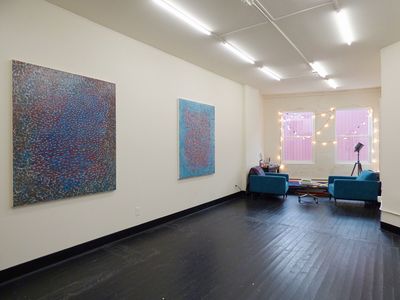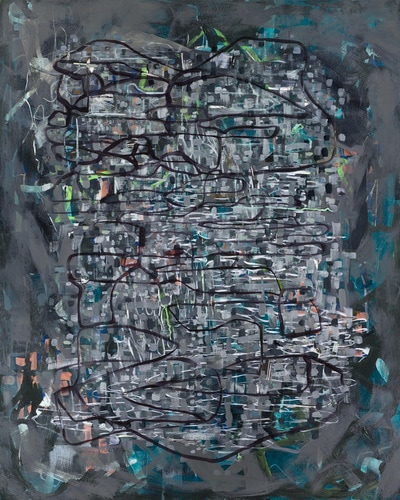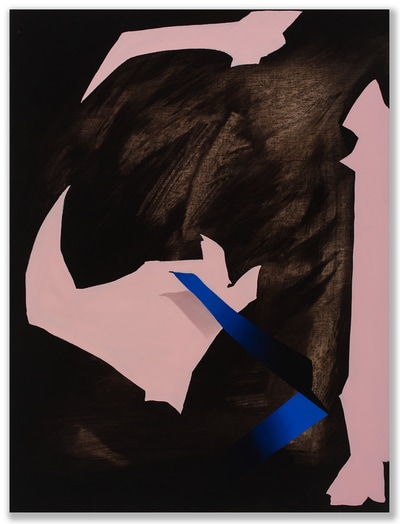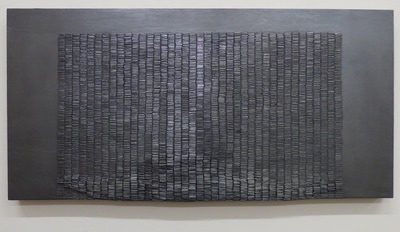JULIE ALPERT & ANDY ARKLEY \ DESERT DAZE
This December we’re delighted to present Julie Alpert and Andy Arkley’s immersive installation, Desert Daze, at Bridge Productions. The prominent feature of Desert Daze is a collaborative installation, including smaller detachable works created by Julie Alpert and Andy Arkley during a yearlong residency in New Mexico at the Roswell Artist in Residence Program. Both artists are well-known for their large-scale installations which reference colorful, graphic imagery and contemporary pop culture. In each of these installations, they construct a brilliantly executed three-dimensional “painting” out of color, shape, and pattern; inviting us to to step into the composition as participants in an up-close and abundantly sensory experience. In their second large-scale collaboration of this kind, Alpert and Arkley thwart the conventional artwork/viewer relationship to place us fully within the work, playing with ideas of aesthetics, content, spectatorship, and meaning.
In Desert Daze, Julie Alpert and Andy Arkley combine their efforts to translate visual information coursing through an endless feedback loop of media, fashion, design, and pop culture. This imagery is then regurgitated through innumerable channels until finally only the symbols, patterns, and decoration remain. Many of the abundant motifs that appeared in Garbled Love Letters reappear in Desert Daze, riffing off a list of repeating symbols which continue to inform this new work: chains, roses, banners, drapes, words like “sm” (as in the abbreviation for small), and jazz hands; as well as the continued use of bows and drips. Also integral to the work is Alpert’s use of light and shadow as elements of the drawings, themselves. As an exercise in restraint, creating a system of rules in which the artist circumnavigates restrictions as a catalyst for new inventions, the materials and palette were limited to craft paper, cardboard, sharpie, and colored pencil. Anchoring a significant figure on the wall as a kind of main character, Desert Daze begins to take shape.
In Desert Daze, Julie Alpert and Andy Arkley combine their efforts to translate visual information coursing through an endless feedback loop of media, fashion, design, and pop culture. This imagery is then regurgitated through innumerable channels until finally only the symbols, patterns, and decoration remain. Many of the abundant motifs that appeared in Garbled Love Letters reappear in Desert Daze, riffing off a list of repeating symbols which continue to inform this new work: chains, roses, banners, drapes, words like “sm” (as in the abbreviation for small), and jazz hands; as well as the continued use of bows and drips. Also integral to the work is Alpert’s use of light and shadow as elements of the drawings, themselves. As an exercise in restraint, creating a system of rules in which the artist circumnavigates restrictions as a catalyst for new inventions, the materials and palette were limited to craft paper, cardboard, sharpie, and colored pencil. Anchoring a significant figure on the wall as a kind of main character, Desert Daze begins to take shape.
EMILY GHERARD \ IT ALL BURNS
This November, Bridge Productions is pleased to announce the return of Seattle-based painter, draughtsman, and printmaker Emily Gherard. Gherard is best known for her powerfully physical paintings and works on paper, built from the accumulation and erosion of repetitive mark-making in charcoal, graphite, acrylic, and oil. Tearing, scratching, and sanding the surface onto which she continually adds material, Gherard builds up a physicality which brings tangible weight and gravity to her pieces. For her latest body of work in It All Burns, Emily Gherard presents a series of new paintings which continue her pursuit of figuratively evocative abstraction, as well as a series of scored graphite drawings on a new material, rubber.
Emily Gherard lives in Seattle Washington. She received her BFA from the Rhode Island School of Design and her MFA from the University of Washington. Her work has been featured in shows at the Seattle Art Fair in both 2017 and 2016; The Henry Art Gallery, Francine Seders Gallery, Seattle City Hall, Cornish College of the Arts, and 4Culture. Emily received the 2006 PONCHO Special Recognition Award and a 2014 GAP Grant. She was finalist for the 2006 and 2010 Betty Bowen Award, a painting finalist for the 2013 Neddy Art Awards at Cornish, and a Stranger Magazine Genius Nominee for in Visual Art in 2014. She has taught for the last ten years throughout the Puget Sound area, including North Seattle College, Everett Community College, Bellevue College, and Western Washington University.
Emily Gherard lives in Seattle Washington. She received her BFA from the Rhode Island School of Design and her MFA from the University of Washington. Her work has been featured in shows at the Seattle Art Fair in both 2017 and 2016; The Henry Art Gallery, Francine Seders Gallery, Seattle City Hall, Cornish College of the Arts, and 4Culture. Emily received the 2006 PONCHO Special Recognition Award and a 2014 GAP Grant. She was finalist for the 2006 and 2010 Betty Bowen Award, a painting finalist for the 2013 Neddy Art Awards at Cornish, and a Stranger Magazine Genius Nominee for in Visual Art in 2014. She has taught for the last ten years throughout the Puget Sound area, including North Seattle College, Everett Community College, Bellevue College, and Western Washington University.
SUSTAINING NEW PATRONAGE: A BRAINSTORMING PROJECT
ARTISTS FEATURED IN THIS GROUP SHOW ARE: JULIE ALPERT, TIM CROSS, SUE DANIELSON, EMILY GHERARD, PATRICK KELLY, DAVE KENNEDY, KAT LARSON, AND DAVID ANDREW NELSON
This October, Bridge Productions presents a series of events designed to collectively investigate, research, and demystify the behind the scenes structure of the gallery model as it currently exists. Ongoing investigations in this series will attempt to: shift the conversation from narratives of failure to narratives of success; demonstrate the way we build, galvanize, and sustain communities; and highlight the tremendous value we bring to those communities and the neighborhoods in which our galleries reside (for example, paying artists is a contribution to the local economy).
We will also work towards identifying questions and seeking solutions for ideas about 21st century patronage, how the avenues through which people engage with the art world are changing, and how people from various sectors and economic backgrounds may gain and benefit from artist and gallery relationships outside of or in addition to buying art. We will also attempt to break open a transparent conversation about the inner workings of a gallery, independent curatorial productions, and artist/producer relationships.
We hope you will join us for our first conversation with COLLECT, a group dedicated to fostering new collectors and creating accessible pathways to the art community in Seattle, on 2nd Saturday at 2pm, right before Art Attack!
We will also work towards identifying questions and seeking solutions for ideas about 21st century patronage, how the avenues through which people engage with the art world are changing, and how people from various sectors and economic backgrounds may gain and benefit from artist and gallery relationships outside of or in addition to buying art. We will also attempt to break open a transparent conversation about the inner workings of a gallery, independent curatorial productions, and artist/producer relationships.
We hope you will join us for our first conversation with COLLECT, a group dedicated to fostering new collectors and creating accessible pathways to the art community in Seattle, on 2nd Saturday at 2pm, right before Art Attack!
GUEST CURATOR DEMIAN DINÉYAZHI´ \ UNARMED
A THREE-PERSON SHOW FEATURING THE WORK OF KALI SPITZER, LIA GRIESSER, & NIKA KAISER
Here in the 21st century, our bodies are still contested spaces of ongoing colonial terror and hegemonic sexism. As we assert common acts of survival and self-determination of our identities within the limiting conceptual framework of Western identity, we walk into the world with this knowledge: our reconciliation with our bodies and the earth is a threat against state violence and patriarchal dominion. To inhabit our bodies is an act of betrayal against heteropatriarchy, so we use our bodies to resist. To use our body is an act of resilience. We use our bodies to create alongside this land that provides us with life and energy. We deliver rituals that solidify our connection to this earth. We are guided by sacred sexuality and afterbirth breaking through the generations of heartache. We come guided by a predestined desideratum of creation and give birth to rhythm and remedy through bodies unarmed.
The artworks included in the exhibition utilize photography and ceramic art to create the foundation for artwork that addresses a revitalization and embodiment of self in direct relationship to the land. The body is situated atop the land, the body is shaping the land and the land shapes the body, history is disrupted and rewritten, and inter-generational healing is re-established.
Demian DinéYazhi’ is an indigenous Diné (Navajo) transdisciplinary artist. His work is rooted in Radical Indigenous Queer Feminist ideology, landscape representation, memory, HIV/AIDS-related art & activism, gender, identity, & sexuality, Indigenous Survivance, & Decolonization. He received his BFA in Intermedia Arts from Pacific Northwest College of Art in 2014. He lives & works in the Indigenous Lands of the Multnomah Tribe (Portland, Oregon).
Demian is the founder & director of the artist / activist initiative, R.I.S.E.: Radical Indigenous Survivance & Empowerment, which is dedicated to the education, perseverance, & evolution of Indigenous art & culture. He is the recipient of the 2017 Brink Award; as well as grants from Evergreen State College (2014), PICA - Portland Institute of Contemporary Art (2014), Art Matters Foundation (2015), & will be an artist-in-residence this November at the Institute of American Indian Art (IAIA) in Santa Fe, New Mexico.
The artworks included in the exhibition utilize photography and ceramic art to create the foundation for artwork that addresses a revitalization and embodiment of self in direct relationship to the land. The body is situated atop the land, the body is shaping the land and the land shapes the body, history is disrupted and rewritten, and inter-generational healing is re-established.
Demian DinéYazhi’ is an indigenous Diné (Navajo) transdisciplinary artist. His work is rooted in Radical Indigenous Queer Feminist ideology, landscape representation, memory, HIV/AIDS-related art & activism, gender, identity, & sexuality, Indigenous Survivance, & Decolonization. He received his BFA in Intermedia Arts from Pacific Northwest College of Art in 2014. He lives & works in the Indigenous Lands of the Multnomah Tribe (Portland, Oregon).
Demian is the founder & director of the artist / activist initiative, R.I.S.E.: Radical Indigenous Survivance & Empowerment, which is dedicated to the education, perseverance, & evolution of Indigenous art & culture. He is the recipient of the 2017 Brink Award; as well as grants from Evergreen State College (2014), PICA - Portland Institute of Contemporary Art (2014), Art Matters Foundation (2015), & will be an artist-in-residence this November at the Institute of American Indian Art (IAIA) in Santa Fe, New Mexico.
PATRICK KELLY \ IN TIME
This August, Bridge Productions is delighted to present In Time, a solo exhibition of new work by Portland artist Patrick Kelly.
Patrick Kelly’s ongoing series of graphite drawings reference the mineral’s crystalline origins, as well as patterns in hematite or obsidian deposits. Their layered construction is a laborious process— Kelly hand-draughts an accumulative form made of jagged overlapping lines, assisted by a jig or stencil of his own design. The resulting effect is an opalescent black mass that shimmers and reflects the light, creating the illusion of a sculptural object in relief on flat paper. For In Time, Kelly's series of new works, he deals with the 18th century philosophical concept of "deep time", noting the exceptionally Sublime nature of geological creation over millennia in relationship to the brief span of a human life; and the profound, indelible mark of our impact on the earth.You may read the full essay which accompanies this show, here.
Patrick Kelly lives and works in Portland, Oregon. He received an MFA in 2005 from The George Washington University in Washington DC and has been showing work in Portland and New York; and in Seattle he’s been featured at Vermillion, Out of Sight, and Bridge Productions.. Kelly’s work has been written about by John Motley for The Oregonian and is included in collections at the MoMA Library, New York, NY and the Bieneke Rare Book and Manuscript Library, Yale, New Haven, CT. He was awarded a commission through Oregon Arts Commission to create work for Eastern Oregon University in their newly renovated Pierce Library.
Patrick Kelly’s ongoing series of graphite drawings reference the mineral’s crystalline origins, as well as patterns in hematite or obsidian deposits. Their layered construction is a laborious process— Kelly hand-draughts an accumulative form made of jagged overlapping lines, assisted by a jig or stencil of his own design. The resulting effect is an opalescent black mass that shimmers and reflects the light, creating the illusion of a sculptural object in relief on flat paper. For In Time, Kelly's series of new works, he deals with the 18th century philosophical concept of "deep time", noting the exceptionally Sublime nature of geological creation over millennia in relationship to the brief span of a human life; and the profound, indelible mark of our impact on the earth.You may read the full essay which accompanies this show, here.
Patrick Kelly lives and works in Portland, Oregon. He received an MFA in 2005 from The George Washington University in Washington DC and has been showing work in Portland and New York; and in Seattle he’s been featured at Vermillion, Out of Sight, and Bridge Productions.. Kelly’s work has been written about by John Motley for The Oregonian and is included in collections at the MoMA Library, New York, NY and the Bieneke Rare Book and Manuscript Library, Yale, New Haven, CT. He was awarded a commission through Oregon Arts Commission to create work for Eastern Oregon University in their newly renovated Pierce Library.
SEATTLE ART FAIR
We're pleased to announce we're spotlighting a solo exhibition by Emily Gherard at the Seattle Art Fair in August 2017. We are all out of VIP passes, but we'll let you know if any more become available! In the meantime, tickets are available through the Seattle Art Fair website. The Artsy preview is here!
We hope you enjoy this interview between Emily and the Seattle Art Fair, and make sure to follow us on Facebook and Instagram!
Emily Gherard composes ebbing and shifting forms to convey a sense of light and depth, each dark shadow a stand-in for the human figure. Her narrative has been built around a sense of everything and nothingness, unity, land, and body; making the indelible unknown relatably human. The narrative she builds allows the viewer to empathize, projecting themselves into the image as though they, themselves, are the subject. Large silhouettes stack up and recede into the distance, rising and falling, crumbling into the foreground or cascading into the darkness below like a flowing cataract. Like their real-world geological counterparts, the forms stand in defiance of their environments, even as they are being shaped by them.
We hope you enjoy this interview between Emily and the Seattle Art Fair, and make sure to follow us on Facebook and Instagram!
Emily Gherard composes ebbing and shifting forms to convey a sense of light and depth, each dark shadow a stand-in for the human figure. Her narrative has been built around a sense of everything and nothingness, unity, land, and body; making the indelible unknown relatably human. The narrative she builds allows the viewer to empathize, projecting themselves into the image as though they, themselves, are the subject. Large silhouettes stack up and recede into the distance, rising and falling, crumbling into the foreground or cascading into the darkness below like a flowing cataract. Like their real-world geological counterparts, the forms stand in defiance of their environments, even as they are being shaped by them.
GRETCHEN FRANCES BENNETT \ THE ROUGH DRAFT OF EVERYTHING
This past July, we were excited to feature Gretchen Frances Bennett’s first solo exhibition with Bridge Productions, The Rough Draft of Everything.
The Rough Draft of Everything features small ceramics, drawings, and collections of stencils. These fragments represent the ephemera of moments, those fleeting bits of memory we attempt to keep in our recollection of significant events. Bennett’s work in capturing, replicating, and elevating these bits and pieces to have meaning as objects creates a circumstance of renewal, and release. In reviving their repetitious forms, she lets go of the moment and of the compulsion to keep them exclusively within her memory, to embed them indelibly in ours. You may read the full essay which accompanies this show, here.
Gretchen Frances Bennett is a Seattle-based artist, whose work has been shown in variety of venues locally and internationally. In 2016, her work was included in the exhibition, The Potato Eaters at Greg Kucera Gallery, Seattle. In 2012, she presented a project with the Drawing Center and the Lower Manhattan Cultural Council in New York. In 2011, her work was featured in the group exhibition, Heel Gezellig at Grimm Gallery, Amsterdam. In 2010, she won an artist residency with the Lower Manhattan Cultural Council, Governors Island, New York. In 2014, she received the Betty Bowen Special Recognition Award. Recently, she has been exploring personal essay and poetry.
The Rough Draft of Everything features small ceramics, drawings, and collections of stencils. These fragments represent the ephemera of moments, those fleeting bits of memory we attempt to keep in our recollection of significant events. Bennett’s work in capturing, replicating, and elevating these bits and pieces to have meaning as objects creates a circumstance of renewal, and release. In reviving their repetitious forms, she lets go of the moment and of the compulsion to keep them exclusively within her memory, to embed them indelibly in ours. You may read the full essay which accompanies this show, here.
Gretchen Frances Bennett is a Seattle-based artist, whose work has been shown in variety of venues locally and internationally. In 2016, her work was included in the exhibition, The Potato Eaters at Greg Kucera Gallery, Seattle. In 2012, she presented a project with the Drawing Center and the Lower Manhattan Cultural Council in New York. In 2011, her work was featured in the group exhibition, Heel Gezellig at Grimm Gallery, Amsterdam. In 2010, she won an artist residency with the Lower Manhattan Cultural Council, Governors Island, New York. In 2014, she received the Betty Bowen Special Recognition Award. Recently, she has been exploring personal essay and poetry.
GUEST CURATOR ASHLEY STULL MEYERS \ THROWN
A TWO-PERSON SHOW FEATURING THE WORK OF ANGELICA MARIA MILLÁN LOZANO AND SOFÍA CÓRDOVA
THROWN is a meditation on the futures of othered bodies through poetic and performative gesture. The included works, both sonic and sculptural, propose a new language for de-colonized, de-gendered societies. Together, these two artists construct communal environments de-centered from patriarchal values with narratives of science fiction and utopian landscapes.
About the artists:
angelica maria millán lozano is a fibers and performance artist de bogotá, colOmbia who moved to portland in pursuit of her mfa in visual studies at pacific northwest college of art. her work questions the ethical implications of social injustices that affect Latinas in the home. she is also a co-founder at cvllejerx, a poc focused fashion collaboration.
Born in 1985 in Carolina, Puerto Rico, Sofía Córdova is a new media artist with a focus on photography, video, music, installation and performance. Her work looks at the things which plague othered bodies particularly as they relate to late global-industrial capitalism, climate change and technology .She is currenty Artist-in- Residnce at the Mills College Museum. Her work is part of Pier 24’s and The Whitney Museum’s permanent collection and was recently the subject of a First Look Feature in Art in America.
About the curator:
Ashley Stull Meyers is a Portland-based writer, editor and curatorial collaborator. She is a recurring contributor to DailyServing, The Exhibitionist and Arts.Black, and has written for Bomb Magazine, Rhizome, and SFAQ/NYAQ; and currently serves the Artist in Residency program at c3:initiative.
About the artists:
angelica maria millán lozano is a fibers and performance artist de bogotá, colOmbia who moved to portland in pursuit of her mfa in visual studies at pacific northwest college of art. her work questions the ethical implications of social injustices that affect Latinas in the home. she is also a co-founder at cvllejerx, a poc focused fashion collaboration.
Born in 1985 in Carolina, Puerto Rico, Sofía Córdova is a new media artist with a focus on photography, video, music, installation and performance. Her work looks at the things which plague othered bodies particularly as they relate to late global-industrial capitalism, climate change and technology .She is currenty Artist-in- Residnce at the Mills College Museum. Her work is part of Pier 24’s and The Whitney Museum’s permanent collection and was recently the subject of a First Look Feature in Art in America.
About the curator:
Ashley Stull Meyers is a Portland-based writer, editor and curatorial collaborator. She is a recurring contributor to DailyServing, The Exhibitionist and Arts.Black, and has written for Bomb Magazine, Rhizome, and SFAQ/NYAQ; and currently serves the Artist in Residency program at c3:initiative.
GAREK J DRUSS \ IMMENSITY WITHOUT HORIZON
This May, Bridge presented artist and composer Garek J. Druss' ethereal and dynamic abstract works in video, music, watercolor, and sculpture.
For Immensity Without Horizon, Druss has created a series of works that quietly underscore the resonant space one feels at the peak of meditative presence, ego death, or release in the midst of the Sublime. The visual pieces in the show are calm, featuring subdued washes of color and pleasing geometrical graphite lines and folds. A series of large watercolor and graphite drawings line the walls of the gallery, gently hovering and vibrating in harmony. Four folded paper sculptures, placed upon mirrored plinths at varying heights, feature soft drawings on their undersides, facing down. Their compositions are only revealed as we lean in close to observe the cast of their image reflected up towards us; unveiling another world, infinitely repeating.
The central focus of the exhibition is an immersive installation of folded paper, sound, and video projection. The prismatic wave of the wall sculpture reflects and refracts the geometry of the video, which pulses and flickers across the paper in a radiant array of subtle color shifts and form. The visuals are meditative and captivating, accompanied by a languid musical score. This soundscape, combined with shimmering subtle color, provokes a strong emotional response; manifesting empathy and unity with other nearby participants who, like us, are bathed in light and sound. As an environment that stimulates multiple sensory responses, Immensity Without Horizon provokes contemplation, thinking, and feeling as a meaningful, communal interaction. Throughout his efforts in recreating the Sublime, Druss inspires a dialog on the metabolization of self-reflection and spirituality in contemporary Western culture.
For Immensity Without Horizon, Druss has created a series of works that quietly underscore the resonant space one feels at the peak of meditative presence, ego death, or release in the midst of the Sublime. The visual pieces in the show are calm, featuring subdued washes of color and pleasing geometrical graphite lines and folds. A series of large watercolor and graphite drawings line the walls of the gallery, gently hovering and vibrating in harmony. Four folded paper sculptures, placed upon mirrored plinths at varying heights, feature soft drawings on their undersides, facing down. Their compositions are only revealed as we lean in close to observe the cast of their image reflected up towards us; unveiling another world, infinitely repeating.
The central focus of the exhibition is an immersive installation of folded paper, sound, and video projection. The prismatic wave of the wall sculpture reflects and refracts the geometry of the video, which pulses and flickers across the paper in a radiant array of subtle color shifts and form. The visuals are meditative and captivating, accompanied by a languid musical score. This soundscape, combined with shimmering subtle color, provokes a strong emotional response; manifesting empathy and unity with other nearby participants who, like us, are bathed in light and sound. As an environment that stimulates multiple sensory responses, Immensity Without Horizon provokes contemplation, thinking, and feeling as a meaningful, communal interaction. Throughout his efforts in recreating the Sublime, Druss inspires a dialog on the metabolization of self-reflection and spirituality in contemporary Western culture.
MICHELLE DE LA VEGA \ THE SUGAR PROJECT
This April, Michelle de la Vega’s The Sugar Project culminated in an exciting dual-venue exhibition of a multidisciplinary blend of site-specific sculptural installation, video, text, spoken word and photography produced through a partnership between Bridge Productions and Oxbow; portions of which included Michelle's collaboration with The Organization for Prostitution Survivors. At Bridge Productions, our space was transformed into a dramatic black box theater and de la Vega presented three large-scale video installations spanning across four walls. In these video installations, artist Michelle de la Vega attempts to confront the historical dominance of the “male gaze” on the female identity and figure, replacing it with a “female gaze” wherein a female artist, with her female subjects, define the way they want to be seen and defined, based on personally intimate information on who they really are and how they really feel. This moves away from the traditional frame of reference in art/media of the female image as the object of desire for the male viewer, replacing it with an examination of what being a women means to women themselves through their own experiences and perceptions, instead of the opposite sex. The content in the sound installation came from dialogue between the artist and participants in the videos.
Partner organizations of The Sugar Project included La Sala, The Organization for Prostitution Survivors, Seattle’s Union Gospel Mission Hope Place Women’s Shelter, The University of WA Women’s Center, and The Seattle Girl’s School. The project gratefully received support from Seattle’s Department of Neighborhoods Matching Fund Program for public community building initiatives and Michelle was excited to be partnering with La Sala as the steering committee on these ventures. The project also gratefully received a generative residency at the Institute of Emergent Technology + Intermedia (iET+I) at Cornish College of the Arts.
Michelle de la Vega is a Seattle based multi-disciplinary artist and community activist. She received her education from Otis Parsons in Los Angeles, CA,Cornish College of the Arts in Seattle, WA, and The South Seattle Community College Welding and Metal Fabrication Program. Through installation, sculpture and mixed media she creates immersive environments that connect communities, illuminate voices and explore concepts that are personally and collectively relevant to the human experience. Michelle has developed an artistically and socially innovative model that integrates specific community groups into the generative processes of her cross-disciplinary installation projects. Delving into authentic partnerships through creative exchange, she draws meaningful connections through social engagement, research, and artistic vision. The focus of Michelle’s creative process and her exhibitions is on moving beyond commentary into experiential endeavors that reframe contexts and create transformation. Her multi-disciplinary practice includes highly crafted 3D, 2D and environmental design, relationship and partnership building, integrated conceptual process, video, performance art and choreography. Michelle’s visual art practice spans 24 years and a 19-year career as a dance and performance artist.
Partner organizations of The Sugar Project included La Sala, The Organization for Prostitution Survivors, Seattle’s Union Gospel Mission Hope Place Women’s Shelter, The University of WA Women’s Center, and The Seattle Girl’s School. The project gratefully received support from Seattle’s Department of Neighborhoods Matching Fund Program for public community building initiatives and Michelle was excited to be partnering with La Sala as the steering committee on these ventures. The project also gratefully received a generative residency at the Institute of Emergent Technology + Intermedia (iET+I) at Cornish College of the Arts.
Michelle de la Vega is a Seattle based multi-disciplinary artist and community activist. She received her education from Otis Parsons in Los Angeles, CA,Cornish College of the Arts in Seattle, WA, and The South Seattle Community College Welding and Metal Fabrication Program. Through installation, sculpture and mixed media she creates immersive environments that connect communities, illuminate voices and explore concepts that are personally and collectively relevant to the human experience. Michelle has developed an artistically and socially innovative model that integrates specific community groups into the generative processes of her cross-disciplinary installation projects. Delving into authentic partnerships through creative exchange, she draws meaningful connections through social engagement, research, and artistic vision. The focus of Michelle’s creative process and her exhibitions is on moving beyond commentary into experiential endeavors that reframe contexts and create transformation. Her multi-disciplinary practice includes highly crafted 3D, 2D and environmental design, relationship and partnership building, integrated conceptual process, video, performance art and choreography. Michelle’s visual art practice spans 24 years and a 19-year career as a dance and performance artist.
DAVID ANDREW NELSON \ P A T H S
This March, Bridge featured P A T H S, a new series of drawings and sculpture by emerging Seattle artist David Andrew Nelson. Combining traditional methods of assemblage, drawing, and painting alongside the use of a programmed plotter machine, Nelson playfully reframes formal aesthetics through his mixed-media constructions. His minimal, architectural sculptures are built with fluorescent tubes, unfinished wood, and exposed cords — ordinary materials placed in a highly aesthetic context. In his drawings, he employs digital tools that rely on calculation rather than expression, exploiting the unknown variables of working with a machine prone to leaving scattered ink artifacts across the paper. These thick, dark lines lay atop an expressive and colorful painting, each plotted mark and color field giving structure to the other. The amorphous, unknown nature of the question is left to our own choosing, and internal reflection.
Nelson’s easily translated aesthetic choices and intuitive conceptual processes allow the objects to work with, rather than against, the viewer's knowledge or background in visual art histories. Each are encouraged to explore their experience and thoughts as valuable participants in a meaningful conversation between artist and audience. Through the playfulness and beauty of Nelson’s creations, we are each invited to participate and enjoy the work for what it is — a joyful exploration of structure, light, form, and color.
Nelson’s easily translated aesthetic choices and intuitive conceptual processes allow the objects to work with, rather than against, the viewer's knowledge or background in visual art histories. Each are encouraged to explore their experience and thoughts as valuable participants in a meaningful conversation between artist and audience. Through the playfulness and beauty of Nelson’s creations, we are each invited to participate and enjoy the work for what it is — a joyful exploration of structure, light, form, and color.
SUE DANIELSON \PERMEABILITY OF HARDNESS
This February, Bridge introduced Seattle painter, printmaker, and multimedia artist Sue Danielson. Danielson's work describes a critical, devoted attention to an accumulation of tangled line and amassed form, built from layers of paint and mixed media. Oftentimes the work resembles topography, geographical data, or a city map, thwarting our sense of scale; or a cryptic visual cipher in which we seek to resolve some recognizable object. Danielson’s newest body of work on paper and panel continues her exploration of maplike forms and treatise on memory and mark-making.
In Permeability of Hardness, Danielson’s first solo show at Bridge, she re-imagines this exploration of recollection and locality on in a more neurological way. In considering the sheer amount of information consumed in the digital age, Danielson enacts a laborious accumulation and submersion of information beneath the rubble of the new. As a painter, this process isn’t just an historical storytelling but a gathering and a documentation. Beginning with a series of marks, she layers her materials in a variegated pattern and calligraphic form using acrylic paint, ink, or graphite. Though meditative to stand in front of and view, in practice it is a deliberate, methodical, and taxing effort employing a series of specific choices and dedication. The tangled growth seems to trace a path of travel through space, mimicking the iconography of a city map, but one that is unfathomably complex and detailed — so much so that it becomes a kind of science fiction landscape. In this way, Danielson’s motion-driven meditation carves a mystical space in which we may spend hours in contemplation of the indelible marks we leave on the land, as well as ourselves.
In Permeability of Hardness, Danielson’s first solo show at Bridge, she re-imagines this exploration of recollection and locality on in a more neurological way. In considering the sheer amount of information consumed in the digital age, Danielson enacts a laborious accumulation and submersion of information beneath the rubble of the new. As a painter, this process isn’t just an historical storytelling but a gathering and a documentation. Beginning with a series of marks, she layers her materials in a variegated pattern and calligraphic form using acrylic paint, ink, or graphite. Though meditative to stand in front of and view, in practice it is a deliberate, methodical, and taxing effort employing a series of specific choices and dedication. The tangled growth seems to trace a path of travel through space, mimicking the iconography of a city map, but one that is unfathomably complex and detailed — so much so that it becomes a kind of science fiction landscape. In this way, Danielson’s motion-driven meditation carves a mystical space in which we may spend hours in contemplation of the indelible marks we leave on the land, as well as ourselves.
GUEST CURATOR BEN GANNON \ MANY LANDS
Alyson Provax, Aramis Hamer, Brit Ruggirello, Catherine Cross Uehara, Counsel Langley, Dakota Gearhart, Emily Gherard, Erin Kendig, Grant Hottle, Isabel Blue, Jake Millett, Jazz Brown, Jennifer Ament, Jesse Higman, Joey Veltkamp, Juan Alonso Rodriguez, Ka'ila Farrell Smith, Kat Larson, Kimberley Cole Trowbridge, Kimisha Turner, Matthew Offenbacher, Patrick Kelly, Robin Green, Tim Cross, Trung Pham
Many Lands was an ambitious and comprehensive exhibition featuring over 20 artists in which abstract and abstracted landscapes represented the idea of “world building”. Historically, this concept takes place in mythopoetic works of fantasy and science fiction literature, but it’s also evocative of actual, inhabitable physical space. In this show, world building is a contextual throughline between the speculative media of both contemporary art and genre fiction.
In the creative practices of both literature and visual art, world building requires deftly balanced and nuanced plot structures: the objective, accessible and recognizable must exist alongside the subjective, intangible, and unknown; mirroring our own world’s composition of sublime and chaotic formation. This alchemical balancing in work that engages with world building produces a creation that is at once generously narrative yet challenging; or raw and filled with potential, providing a touchstone in reality while engaging us to stretch and embrace the fabric of our imagination to absorb new ideas.
The philosophical urgency underlying the imagination of other worlds is rooted in empathy and compassion, which serves as a device to enable a translation through our distance in space and time. In this way, our empathy leads us to a deeper understanding of previously obscured ideas, theories, or existences. These glimpses into those fictitious realms outside ourselves allows us to see the many lands that both envelope, comprise, and connect us all.
-- Ben Gannon, January 2017
Many Lands was an ambitious and comprehensive exhibition featuring over 20 artists in which abstract and abstracted landscapes represented the idea of “world building”. Historically, this concept takes place in mythopoetic works of fantasy and science fiction literature, but it’s also evocative of actual, inhabitable physical space. In this show, world building is a contextual throughline between the speculative media of both contemporary art and genre fiction.
In the creative practices of both literature and visual art, world building requires deftly balanced and nuanced plot structures: the objective, accessible and recognizable must exist alongside the subjective, intangible, and unknown; mirroring our own world’s composition of sublime and chaotic formation. This alchemical balancing in work that engages with world building produces a creation that is at once generously narrative yet challenging; or raw and filled with potential, providing a touchstone in reality while engaging us to stretch and embrace the fabric of our imagination to absorb new ideas.
The philosophical urgency underlying the imagination of other worlds is rooted in empathy and compassion, which serves as a device to enable a translation through our distance in space and time. In this way, our empathy leads us to a deeper understanding of previously obscured ideas, theories, or existences. These glimpses into those fictitious realms outside ourselves allows us to see the many lands that both envelope, comprise, and connect us all.
-- Ben Gannon, January 2017















